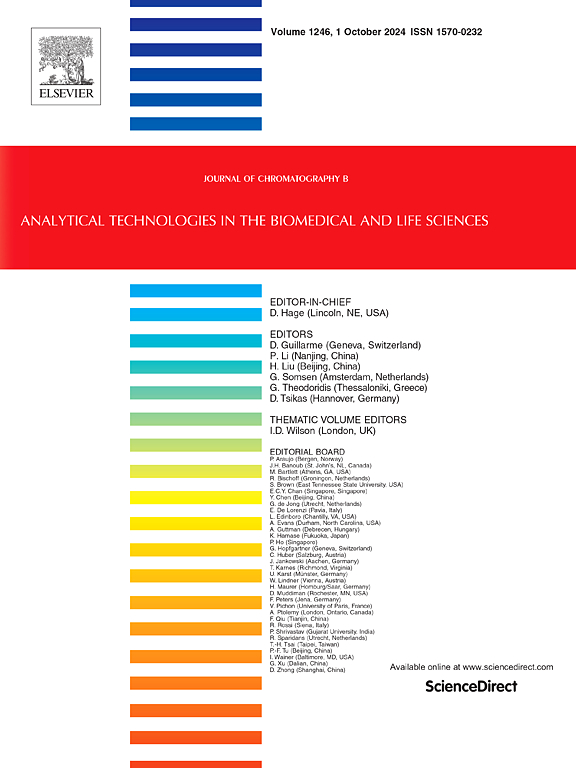用 UPLC-MS/MS 法测定人血浆和脑脊液中的呋莫替尼--在有脑转移和无脑转移肺癌患者中的应用
IF 2.8
3区 医学
Q2 BIOCHEMICAL RESEARCH METHODS
引用次数: 0
摘要
呋莫替尼 (AST2818) 是一种选择性表皮生长因子受体 (EGFR) 酪氨酸激酶抑制剂 (TKI),目前正在开发用于治疗 EGFR 突变阳性的非小细胞肺癌患者。血浆和脑脊液(CSF)中呋莫替尼的定量可用于评估呋莫替尼对中枢神经系统(CNS)的渗透。本文介绍了超高效液相色谱-串联质谱(UPLC-MS/MS)方法,用于定量检测人血浆和脑脊液中的呋莫尼替尼。样品经乙腈简单蛋白质沉淀后,在 Kinetex C18 色谱柱(100 mm × 2.1 mm, 2.6 μm)上分离。流动相为乙腈和 5 mM 乙酸铵加 0.2 % 甲酸水溶液。定量离子对为 m/z 569.3 → 72.2(呋莫替尼)和 m/z 526.5 → 72.2(奥莫替尼),后者被用作内标(IS)。在 0.5-200 纳克/毫升(血浆样品)和 0.05-30 纳克/毫升(脑脊液样品)的浓度范围内,校准曲线显示出良好的线性关系(r2 > 0.99)。精密度(RSD)≤7.86 %,准确度在 96.2 %-109.3 % 范围内,均符合接受标准。基质效应为 94.3 % 至 102.1 %。分析物的回收率在 93.3 % 至 98.9 % 之间。所建立的分析方法在分析人血浆和脑脊液中的呋喃替尼时显示出极高的灵敏度、简便性、准确性和可靠性。该检测方法有助于预测呋莫尼替尼的疗效和毒性,从而实现肺癌患者的精准医疗。本文章由计算机程序翻译,如有差异,请以英文原文为准。
Determination of furmonertinib in human plasma and cerebrospinal fluid by UPLC-MS/MS: Application in lung cancer patients with and without brain metastasis
Furmonertinib (AST2818) is a selective epidermal growth factor receptor (EGFR) tyrosine kinase inhibitor (TKI) being developed for the treatment of patients with EGFR mutation-positive non-small cell lung cancer. Quantification of furmonertinib in plasma and cerebrospinal fluid (CSF) can be used to assess penetration of furmonertinib into the central nervous system (CNS). This paper described ultra-performance liquid chromatography tandem mass spectrometry (UPLC-MS/MS) methods for quantification of furmonertinib in human plasma and CSF. Sample separation was achieved on a Kinetex C18 column (100 mm × 2.1 mm, 2.6 μm) after simple protein precipitation with acetonitrile. The mobile phase was composed of acetonitrile and 5 mM ammonium acetate with 0.2 % formic acid in water. Quantitative ion pairs were m/z 569.3 → 72.2 for furmonertinib and m/z 526.5 → 72.2 for aumolertinib, which was used as the internal standard (IS). The calibration curves showed good linearity (r2 > 0.99) over concentration range of 0.5–200 ng/mL(plasma sample) and 0.05–30 ng/mL(CSF sample). The precision (RSD) was ≤7.86 %, and the accuracy fell within the range of 96.2 %–109.3 %, all meeting acceptance criteria. The matrix effect was from 94.3 % to 102.1 %. The recovery of analytes fell within the range of 93.3 %–98.9 %. The established analytical methods showed great sensitivity, simplicity, accuracy and reliability for the analysis of furmonertinib in human plasma and CSF. This assay would be helpful to predict the effectiveness and toxicities of furmonertinib in the pursuit of precision medicine for lung cancer patients.
求助全文
通过发布文献求助,成功后即可免费获取论文全文。
去求助
来源期刊

Journal of Chromatography B
医学-分析化学
CiteScore
5.60
自引率
3.30%
发文量
306
审稿时长
44 days
期刊介绍:
The Journal of Chromatography B publishes papers on developments in separation science relevant to biology and biomedical research including both fundamental advances and applications. Analytical techniques which may be considered include the various facets of chromatography, electrophoresis and related methods, affinity and immunoaffinity-based methodologies, hyphenated and other multi-dimensional techniques, and microanalytical approaches. The journal also considers articles reporting developments in sample preparation, detection techniques including mass spectrometry, and data handling and analysis.
Developments related to preparative separations for the isolation and purification of components of biological systems may be published, including chromatographic and electrophoretic methods, affinity separations, field flow fractionation and other preparative approaches.
Applications to the analysis of biological systems and samples will be considered when the analytical science contains a significant element of novelty, e.g. a new approach to the separation of a compound, novel combination of analytical techniques, or significantly improved analytical performance.
 求助内容:
求助内容: 应助结果提醒方式:
应助结果提醒方式:


